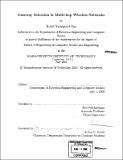| dc.contributor.advisor | Hari Balakrishnan. | en_US |
| dc.contributor.author | Rao, Rohit Navalgund | en_US |
| dc.contributor.other | Massachusetts Institute of Technology. Dept. of Electrical Engineering and Computer Science. | en_US |
| dc.date.accessioned | 2007-04-03T17:08:13Z | |
| dc.date.available | 2007-04-03T17:08:13Z | |
| dc.date.copyright | 2005 | en_US |
| dc.date.issued | 2005 | en_US |
| dc.identifier.uri | http://hdl.handle.net/1721.1/37068 | |
| dc.description | Thesis (M. Eng.)--Massachusetts Institute of Technology, Dept. of Electrical Engineering and Computer Science, 2005. | en_US |
| dc.description | Includes bibliographical references (p. 61-63). | en_US |
| dc.description.abstract | This thesis describes the implementation of MultiNAT, an application that attempts to provide the benefits of client multi-homing while requiring minimal client configuration, and the evaluation of a novel link-selection algorithm, called AvMet, that significantly outperforms earlier multi-homing methods. The main motivation behind MultiNAT is the growing popularity of cheap broadband Internet connections, which are still not reliable enough for important applications. The increasing prevalence of wireless networks, with their attendant unpredictability and high rates of loss, is further exacerbating the situation. Recent work has shown that multi-homing can increase both Internet performance as well as the end-to-end availability of Internet services. Most previous solutions have required complicated client configuration or have routed packets through dedicated overlay networks; MultiNAT attempts to provide a simpler solution. MultiNAT automatically forwards connection attempts over all local interfaces and uses the resulting connection establishment times along with link-selection metrics to select which interface to use. | en_US |
| dc.description.abstract | (cont.) MultiNAT is able to sustain transfer speeds in excess of 4 megabytes per second, while imposing only an extra 150 microseconds of latency per packet. MultiNAT supports a variety of link-selection metrics, each with its own strengths and weaknesses. The MONET race-based scheme works well in wired networks, but is misled by the unpredictable nature of wireless losses. The ETT metric performs relatively well at finding high-throughput paths in multi-hop wireless networks, but can be incorrect when faced with heavy load. Unfortunately, neither of these metrics address end-to-end performance when packets traverse both wired and wireless networks. To fill this need, we propose AvMet, a link-selection scheme that tracks past connection history in order to improve current predictions. We evaluate AvMet on a variety of network configurations and find that AvMet is not misled by wireless losses. AvMet is able to outperform existing predictors in all network configurations and can imp:rove end-to-end availability by up to half an order of magnitude. | en_US |
| dc.description.statementofresponsibility | by Rohit Navalgund Rao. | en_US |
| dc.format.extent | 63 p. | en_US |
| dc.language.iso | eng | en_US |
| dc.publisher | Massachusetts Institute of Technology | en_US |
| dc.rights | M.I.T. theses are protected by copyright. They may be viewed from this source for any purpose, but reproduction or distribution in any format is prohibited without written permission. See provided URL for inquiries about permission. | en_US |
| dc.rights.uri | http://dspace.mit.edu/handle/1721.1/7582 | |
| dc.subject | Electrical Engineering and Computer Science. | en_US |
| dc.title | Gateway selection in multi-hop wireless networks | en_US |
| dc.type | Thesis | en_US |
| dc.description.degree | M.Eng. | en_US |
| dc.contributor.department | Massachusetts Institute of Technology. Department of Electrical Engineering and Computer Science | |
| dc.identifier.oclc | 82540557 | en_US |
